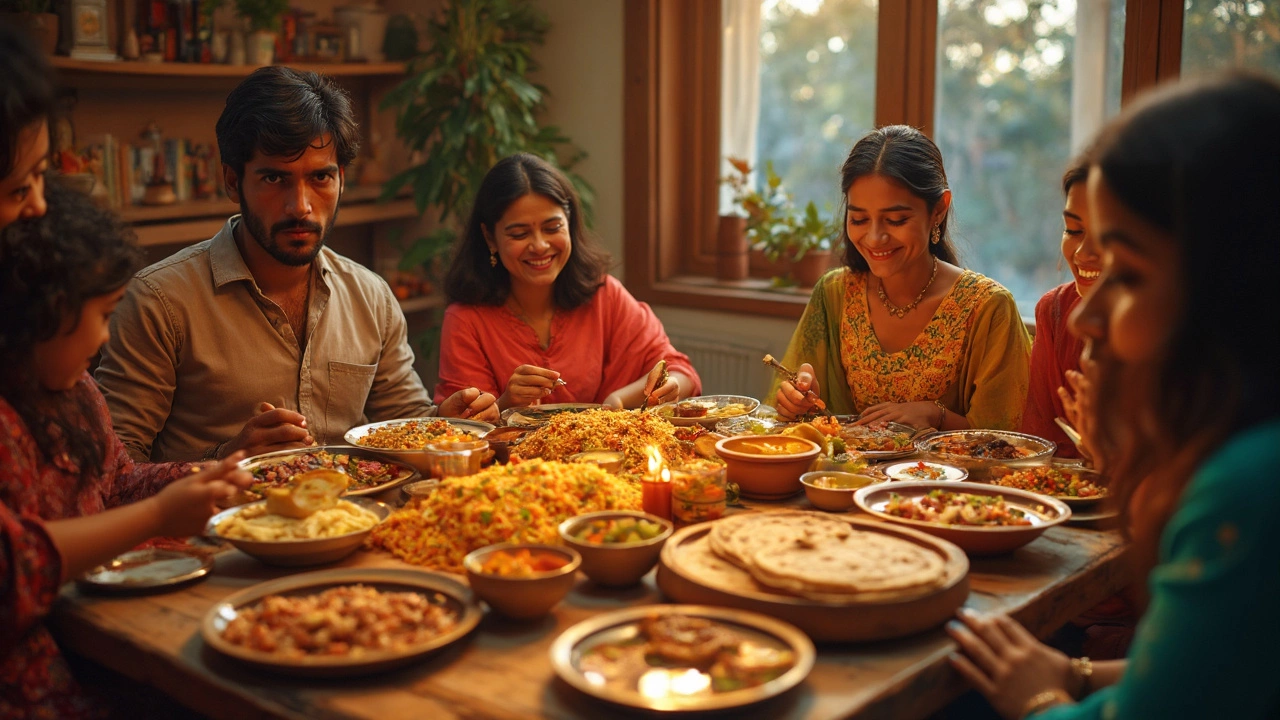Which Country Eats the Least Meat? Insights on Vegetarian Traditions
 Jun, 3 2025
Jun, 3 2025
Ever thought about how much meat people actually eat around the world? The answer might surprise you. While a lot of countries love their chicken, beef, and pork, there’s one place that really stands out for eating the least: India. We’re talking about a country where over 30% of people follow a vegetarian diet, and many more skip meat for religious or cultural reasons. That’s a record no other country comes close to.
The low numbers aren’t just a random trend—they’re tied to deep traditions and beliefs. If you’ve ever wondered how this influences what ends up on people’s plates, especially when it comes to Indian food, you’re in for some interesting facts. You’ll also pick up a few practical ideas to try at home, even if you’ve never cooked a vegetarian meal before. Curious? Keep reading and you’ll see why Indian kitchens are a goldmine for veggie lovers.
- The Country that Eats the Least Meat
- Why India Leads in Vegetarianism
- Popular Vegetarian Indian Dishes
- How to Start Eating More Vegetarian Meals
The Country that Eats the Least Meat
If you’re wondering which country takes the lead for eating the least meat, all signs point straight to India. This isn’t just a guess—it’s backed up by hard numbers. According to the OECD and the Food and Agriculture Organization, the average person in India eats less than 5 kilograms of meat per year. Compare that to the U.S., where people can eat more than 100 kilograms a year! That’s a massive gap.
Why does India eat so little meat? It mostly comes down to religion and tradition. A huge part of the population follows Hinduism, Jainism, and Buddhism. All these religions promote vegetarianism in some way. For many families, meat just isn’t part of the daily menu. In fact, for millions, it never makes it onto the menu.
Here’s a quick look at the latest meat consumption data from around the world:
| Country | Average Meat Consumption per Person (kg/year) |
|---|---|
| India | 4.9 |
| Bangladesh | 7.3 |
| Indonesia | 11.6 |
| Japan | 46.9 |
| United States | 124.1 |
What stands out here is just how much lower India’s numbers are compared to everywhere else. Even other low-meat countries can’t match it.
But this isn’t only about beliefs—it’s also about cost and access. Meat tends to be pricier in India, especially compared to vegetables, grains, and legumes. Families get their protein from dals (lentils), paneer, chickpeas, and a bunch of other tasty plant-based sources. It’s not just a tradition—it’s a way of life that helps keep meat off the center of the table.
Why India Leads in Vegetarianism
If you check the numbers, nothing comes close to India’s love for vegetarian food. Around 38% of the population in India identifies as vegetarian. That’s over 500 million people—bigger than the populations of most countries. So why is India the country that eats the least meat?
The roots go way back. Many Indians avoid meat due to religious and cultural beliefs. Hinduism, Jainism, and Buddhism all encourage vegetarian eating. For example, Jainism doesn’t just skip meat but even avoids root vegetables to prevent harming small organisms. Around 80% of Indians are Hindu, and cows are considered sacred. For these groups, eating meat is more than just a dietary choice—it’s about following deep traditions.
But it’s not just about religion. For years, meat was expensive and hard to get in many parts of India, especially in rural areas. People got used to making tasty, filling meals from lentils, beans, vegetables, and grains. The result? Vegetarian meals that aren’t bland or boring at all.
Let’s put things in perspective with a quick table showing yearly meat consumption per person:
| Country | Annual Meat Consumption (kg/person) |
|---|---|
| India | 4-5 |
| USA | 100 |
| Brazil | 99 |
| UK | 75 |
See the gap? The average Indian eats less than 5 kilos of meat a year, compared to over 20 times that in the US.
And here’s something cool: Even non-vegetarians in India eat much less meat than people in other countries. Festivals, fasting days, and family routines often call for plant-based meals a few times a week, which all adds up.
No wonder India is known for its amazing vegetarian Indian dishes—the tradition runs deep, and the country has made an art out of it.

Popular Vegetarian Indian Dishes
When you talk about Indian food, you can't skip the huge range of tasty vegetarian dishes. India is famous for turning regular veggies, lentils, and grains into meals that make you forget meat even exists. Whether you’re new to Indian food or already a fan, there’s always something new to try that packs a punch with flavor and nutrition.
Check out this quick glance at some of the most-loved vegetarian Indian dishes and how many people actually enjoy them across the country:
| Dish | Main Ingredients | How Popular? |
|---|---|---|
| Paneer Butter Masala | Indian cottage cheese, tomato gravy, cream | Served in over 70% of North Indian restaurants |
| Chana Masala | Chickpeas, tomato, onion, spices | Favorite in home cooking, especially in Delhi and Mumbai |
| Masoor Dal | Red lentils, spices, tomatoes | Staple in daily meals across India |
| Aloo Gobi | Potato, cauliflower, spices | Common side dish, often packed in lunch boxes |
| Baingan Bharta | Roasted eggplant, onions, tomatoes, spices | Loved at family dinners and festivals |
Spices do most of the heavy lifting in these recipes, making simple veggies taste rich and satisfying. Food like vegetarian Indian dishes have such a reputation that even in global cities like London and New York, you’ll find these classics on Indian restaurant menus.
- Paneer Butter Masala is cheesy, buttery, and saucy—perfect with naan or rice.
- Chana Masala is spicy and protein-rich, thanks to chickpeas, and pairs well with flatbreads.
- Masoor Dal is full of protein and fiber and is super easy to make at home—just lentils, water, and everyday spices.
- Aloo Gobi mixes potatoes and cauliflower with turmeric and cumin for a bright, flavorful side.
- Baingan Bharta has a smoky kick, since the eggplant is roasted on an open flame before being mashed and mixed with onion and tomato.
The best part? You don’t need fancy tools or rare ingredients. Most of these dishes take under an hour and use things you probably already have. That’s why these meals are everywhere—from tiny roadside stalls to fancy dinners. So if you're looking for an easy way to start eating less meat, Indian vegetarian cooking is a pretty safe bet.
How to Start Eating More Vegetarian Meals
If eating less meat feels tricky, you’re not alone. But making the switch doesn’t have to be a huge leap. Start by thinking about what you enjoy eating already. You’ll probably notice a bunch of vegetarian options you never focused on before.
The big player here is India, where vegetarian meals are just everyday food. A huge chunk of the country—over 30%—eats mainly plant-based meals. And they don’t settle for boring options. Indian cuisine is loaded with flavors even without meat. You can take some ideas straight from their kitchen.
- least meat-eating country: Look at how Indian families swap meat for beans, lentils, and paneer. Dal, chana masala, and rajma are all packed with protein and taste good with rice or flatbreads.
- Start simple: Replace chicken in your curry with chickpeas or potatoes. When making wraps, throw in grilled veggies and spiced paneer.
- Batch cook: Indian dishes like dal or sabzi are easy to cook in big batches and store for the week. That way, you’ve always got a veggie meal ready.
- Spice is your friend: Indian food uses lots of spices, so you won’t miss meat. Cumin, coriander, ginger, and turmeric bring real flavor to your meals.
Here’s a quick look at some easy vegetarian protein swaps versus popular meats, so you still get enough protein:
| Food | Serving Size | Protein (grams) |
|---|---|---|
| Chicken Breast (cooked) | 100g | 27g |
| Lentils (cooked) | 100g | 9g |
| Paneer (cottage cheese) | 100g | 14g |
| Chickpeas (cooked) | 100g | 8g |
| Eggs (boiled) | 2 large | 13g |
Switching to more vegetarian meals also means you’ll probably eat more fiber and get a bigger variety of vitamins. Plus, plant-based meals are often cheaper and can be easier on your stomach.
If you want to try it for a week, make a list of your favorite Indian dishes and swap out any meat, or follow a simple vegetarian recipe. You’ll see that you really don’t miss out on flavor—or fullness—at all.